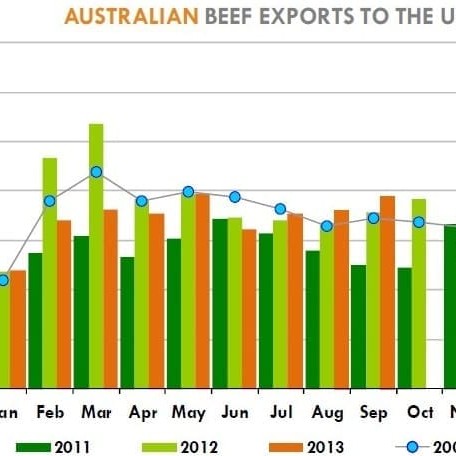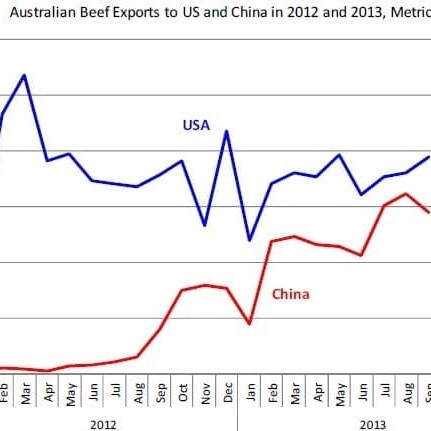While the ongoing US Federal Government shutdown is causing big disruptions in the US domestic beef industry, the effects do not appear to be as great on the imported beef trade so far, market watchers suggest.
 Last week’s financial shutdown of the US Federal Government has caused an unprecedented blackout in the generation of US beef industry data, which is the lifeblood of the country’s live cattle and wholesale beef markets.
Last week’s financial shutdown of the US Federal Government has caused an unprecedented blackout in the generation of US beef industry data, which is the lifeblood of the country’s live cattle and wholesale beef markets.
Based on legislation passed through the US Congress, USDA has over the years created a sophisticated catalogue of mandatory reporting information that provides daily updates of supply, demand and pricing trends.
Many markets rely on this easy transparent flow of information.
Every day, USDA provides an account of the actual prices that packers paid for cattle and beef products.
The USDA also provides an account not just of how many animals came to market but the weight and grading of those animals. This allows for a much more efficient process in purchasing product (buyers and sellers spend less time on the phone trying to ‘find the right price’).
It also provides futures market with ample information to trade on expectations for future prices.
All this marketing machinery has now come to a stop and US market participants are grappling with new ways to price product.
The North American Meat Association said the entire USDA.gov website was out of service last week, causing “a great deal of consternation among stakeholders seeking basic information.”
Hardest-hit were those relying on USDA Market News for formula pricing, NAMA said.
About 60pc of all beef traded in the US is now sold ‘off the sheet’ on formula pricing, rather than on a negotiated price. No wonder, then, that when USDA stopped releasing daily price information a week ago, that both US packers and their customers were scrambling to find a solution for all the meat that was booked on a formula basis.
US Cattle Buyers Weekly publisher Steve Kay says the US industry had relied more and more on USDA data since the advent of mandatory price reporting in 2001.
“No USDA data was available last week, meaning that USDA reports on everything from feeder cattle prices to beef by-product values were unavailable,” Mr Kay said.
The last time such a Federal shutdown occurred was 17 years ago. On that occasion the standoff lasted 21 days, but it occurred before the US Mandatory Price Reporting took effect, which has since provided the US industry with much more live animal and meat trade data.
“A shutdown now of a similar length will impact the US beef industry’s ability to discover prices all the way from feeder cattle to the meat case,” Mr Kay said. “It will especially impact the formula pricing of live cattle and beef, as that pricing is based on USDA prices.”
Last week’s immediate concern was how to formula price beef cuts, grinds and trim. The shutdown left observers wondering if it would force more beef to sell on the spot market or whether the beef trade overall would slow down, Mr Kay said.
While the shutdown has had considerable impact on price discovery, the US Department of Agriculture continues to provide inspection services in meat processing plants, as inspection is regarded as an essential government service.
As a result, daily US cattle slaughter last week was not impacted, although no one knew how many cattle were processed. This added another uncertainty to the beef market, leading some buyers to purchase only to fill their immediate needs, analysts said.
In its weekly imported beef summary last week, Steiner Consulting said while current stop-gap pricing solutions devised by packers could prove to be workable, much would depend on how long the USDA shutdown lasted.
“The longer the situation continues, the more difficult it will be to efficiently trade beef in the US,” the Steiner report said.
“Price discovery is difficult in the best of circumstances, at this point most market participants are flying blind and we will likely see more trade go on a negotiated basis rather than rely on packer specific pricing sheets,” it said.
So what are the implications for Australian imported beef under the current US conditions?
In the short term, Steiner thinks the impact will be somewhat limited. Prices for domestic lean grinding beef were for the most part a known among market participants, and the lack of the USDA report would probably have a limited impact.
“The mandatory price reporting did not extend to imported beef and industry was already used to relying on reports from third-party sources,” it said.
The confusion in the broader domestic beef market could have secondary impacts if the chaotic situation continued, however.
With little clarity on cattle and beef prices, end-users could opt to sit on the sidelines and buy only for immediate needs, Steiner suggested.
“Overall this is not good for beef demand, including that for imported beef. While the government shutdown does not affect the USDA meat inspection activities, it likely does impact some of the administrative functions that go into bringing beef into the US. We could see some delays in processing imported loads,” it said.
“The bottom line is that all the confusion and chaos in the US domestic beef market will make for a challenging trading environment for imported beef in the short term, and we have no idea how the Washington political theatre will play out,” Steiner’s report said.
90CL imported pricing little changed
Prices for imported 90CL grinding beef were little changed from a week earlier when reported on Friday, quoted by MLA at A425c/kg FAS, 1c/kg down on the previous week, and 37c/kg better than this time last year.
 Steiner reported imported lean grinding beef trading for the week as ‘slow’. Asking prices in Australia and NZ remained firm, but US end-users for the most part were content to pass and bids were steady compared to the previous week. Asking prices in overseas markets were often near FOB US domestic prices, which made for a difficult trading environment.
Steiner reported imported lean grinding beef trading for the week as ‘slow’. Asking prices in Australia and NZ remained firm, but US end-users for the most part were content to pass and bids were steady compared to the previous week. Asking prices in overseas markets were often near FOB US domestic prices, which made for a difficult trading environment.
“While in past years some traders were willing to take on some positions, given the propensity of prices to move upwards in November and December, the recent counter-seasonal moves in imported beef trading have made many market participants much more cautious,” Steiner said.
“While it’s true that domestic US lean beef supplies are expected to be tight, there is significantly more risk in the market than in past years. Many end-users are content to stay short-bought, rather than take on forward positions that hold a significant premium to current spot FOB values.”
